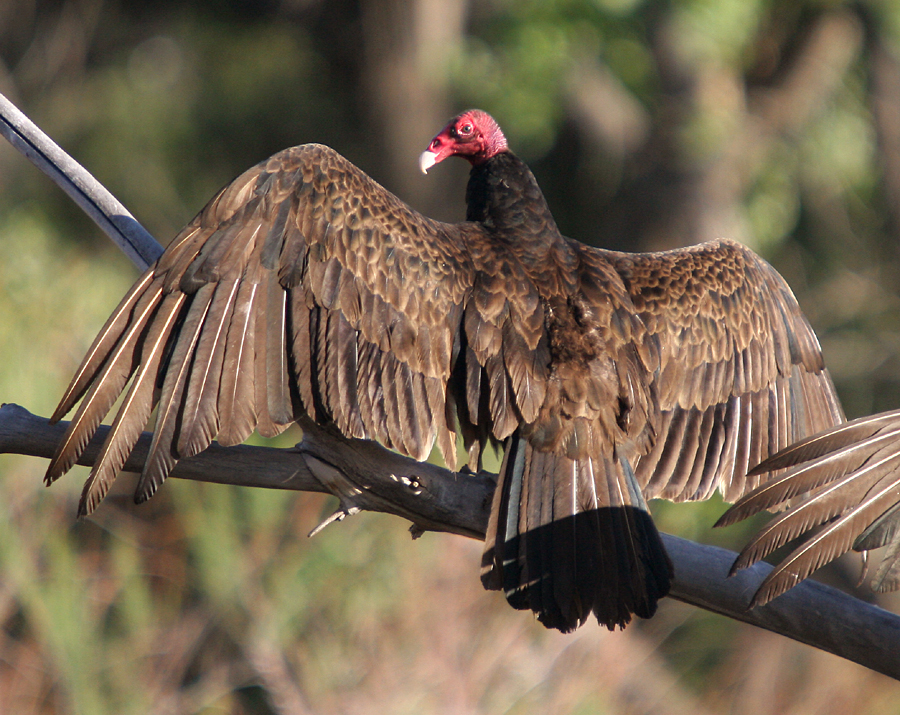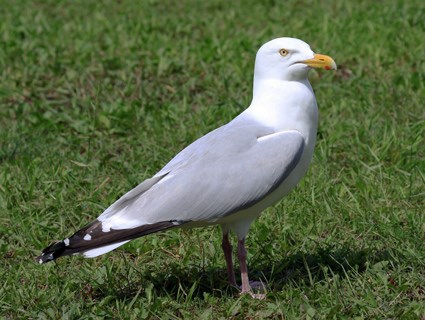Our dead fish turned out to be a Longnose Gar. A super cool prehistoric looking guy with armor-like scales and a looong mouth full of pointy little teeth. Had my camera (phone) not been both out of batteries and in the cabin I would have taken a picture, but it was both of those things, so here's a artists rendition of what our fish would have looked like alive. Now picture it with just bones for a head, dry, no insides and it's fins slightly nibbled.
 |
| http://commons.wikimedia.org/wiki/File:Longnose_gar.jpg |
Decomposition begins almost immediatly at death and involves two processes: autolysis, which is the body's internal chemicals and enzymes breaking down it's own tissue, and putrefaction (awesome name eh?), which is breakdown of tissues by external bacteria. This tissue breakdown releases gas which is that unmistakable "something is dead here" smell. Like when the mouse died in our wall.
So let's start big. Turkey Vulture. Yes, it's a little weird that a seven-year-old has it as one of her favourite birds, but they are pretty cool, if not pretty. It has an incredible sense of smell, which is really rare among birds - many of which can't smell at all. They have no feathers on their head so as not to pick up bacteria when they stick their heads in a carcass (my apologies to anyone having a snack while reading this). They also have a well developed immune system, which is why they don't get the diseases we would from eating decomposing things (like salmonella, botulism, cholera...fun stuff like that). Stop eating now if you were. They like freshly dead stuff but sometimes have to wait for a bit of "softening" before they can pierce through the skin. They eat the soft bits first. |
| How can you not love this face? By Mjobling (Own work) [GFDL (http://www.gnu.org/copyleft/fdl.html) or CC-BY-3.0 (http://creativecommons.org/licenses/by/3.0)], via Wikimedia Commons |
I used to work with Herring Gulls, so I've got a bit of a soft spot for them. Which incidentally is probably on my head from where they used to smack me while I was working. These are not to be confused with the smaller Ring-billed Gull, which is the one you find eating fries in the parking lot. Herring Gulls are, for the most part, seafood eaters. They also like insects, worms, eggs, chicks of other species and carrion (dead stuff) if the opportunity arises, particularly dead fish. So this guy is one of our likely suspects for eating the Gar, considering there is no shortage of them where we were.
 |
| What are you looking at? Dead fish are easy to catch. © Laura Erickson, MN, Tettegouche State Park, June 2010 |
Then in come the insects. Flies and their larva (everyone's favourite - maggots!), worms, beetles - ain't no party like a dead fish party! By eating away at the fish they open it up to the microscopic stuff. Maggots are so good at this, and so specialized to eat only dead, rotting things that they are once again being used in medicine for treating non-healing wounds.
So now that the big parts have been eaten, who does the rest of the clean-up? The Decomposers. It really should be a title of a movie or something, I think something mafia-related or maybe a funny heist film. But what it's really referring to in this case is a variety of bacteria. Bacteria have a really useful purpose here by breaking down everything that didn't get eaten into simpler matter, turning our dead fish back into soil.
There are 5 stages of decompostion - Fresh, Bloat, Active, Advanced Decay and Dry/Remains. Our fish was in number five - just bones and scales. Fresh is where the scavengers come in, taking what they can for dinner. The Fresh stage is the one where the body changes colour (livor mortis), goes rigid for a bit (rigor mortis) and cools down (algor mortis) and as any good fan of CSI should know, these are key for finding out the time of death (which doesn't matter for our fish really), also you need cool in-the-air swipey computers and a bunch of random pipetting.
Bloat is exactly what it sounds like - a build up of gases that cause the dead thing to puff up. Caution when poking things in the bloat stage with a stick, they can indeed pop. And that's not a fun kind of piñata. This is when the insects move in too. Active Decay and Advanced Decay are the time when the decomposers are really in their element. It is basically the massive breakdown of tissue (active) and the end of that cycle (advanced) where the maggots have had their fill and move on to the couch for a nap (OK, actually they pupate) and the bacteria clean up and do the dishes. Dry/Remains is where our fish was - skin/scales, cartilage and bones - only non-edible stuff is left. The end of the food chain. The nutrients go back into the soil to be taken up into the plant roots and begin the cycle back up again. The ultimate recyclers, those decomposers. There are bacteria (and fungi and actinomycetes) to specialize in nearly everything - dead plants, dead animals, poop - it all gets broken down and reused.
It's quite a feat in teamwork. All these creatures work together to make the world a cleaner place. Now if I can just get a gull to do my laundry...

No comments:
Post a Comment